The first squadron focused solely on recruiting Battlefield Airmen and combat support career fields stood up recently in a ceremony at the Medina Annex on Joint Base San Antonio – Lackland.
The reactivation of the 330th Recruiting Squadron, U.S. Air Force Recruiting’s 28th squadron, marks the first time in Air Force history that a unit will be dedicated to recruiting men and women for hard-to-fill positions within special operations and combat support roles.
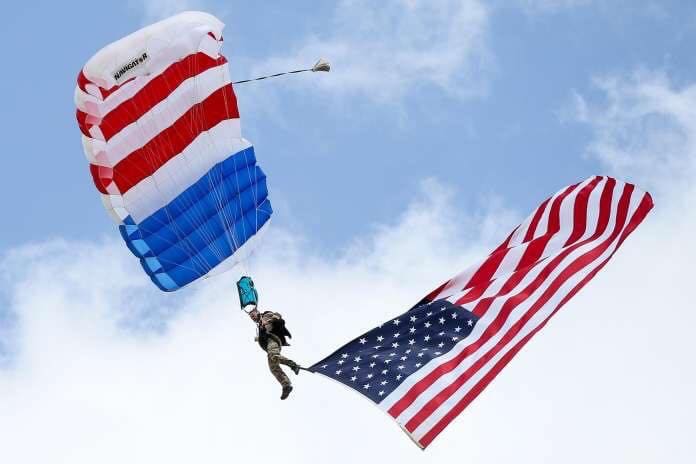
The reactivation began with members of the Battlefield Airmen Training Group and the 330th RCS freefalling into the ceremony with the squadron guidon and the American Flag. Col. Ron Stenger, BATG commander and a special tactics officer, passed the guidon to Col. Robert Trayers, AFRS vice commander, and former commander of the 330th RCS when it was deactivated back in 2009.
Following the jump, members of the 330th RCS participated in memorial pushups at the Lt. Col. William Schroeder Memorial.
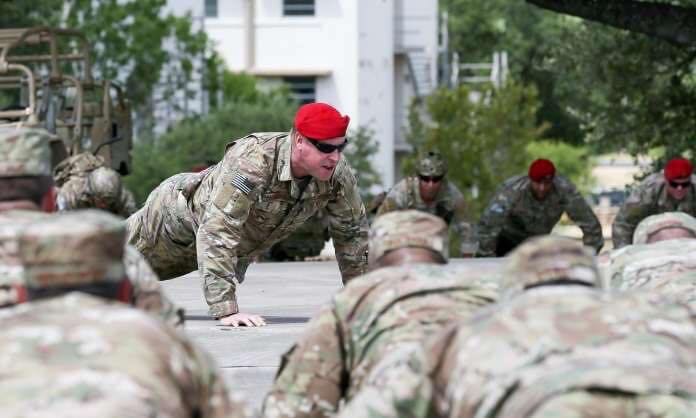
“Memorial pushups are a tradition in our community to recognize and honor our fallen comrades,” said Master Sgt. Benjamin Hannigan, a liaison to AFRS from the 24th Special Operations Wing. “They are usually done after strenuous physical activity, because our fallen comrades did more than their physical body could. Our physical sacrifice of remembrance could never match up to their sacrifice.”
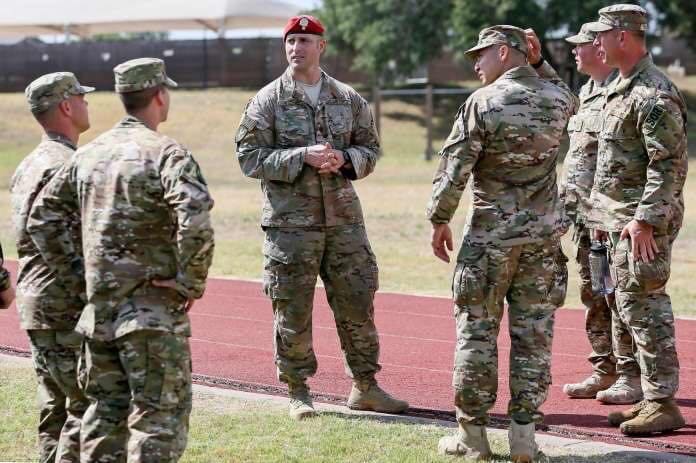
Shortly after the memorial pushups, the official party moved into the Lt. Col. Schroeder Auditorium for the assumption of command ceremony. Trayers provided remarks about the squadron’s heritage.
“It’s great to be able to reactivate this squadron with a great team and new leaders,” Trayers said. “You now have the important responsibility of recruiting the folks you want at the tip of the spear of our nation.”
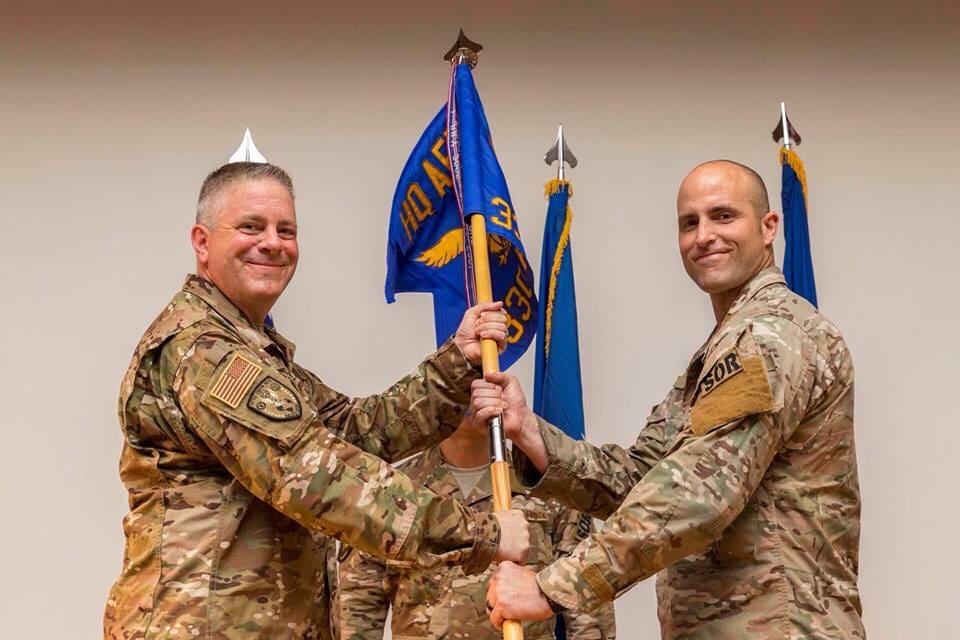
The reason for activating the 330th RCS was to overcome the challenges of recruiting and training Battlefield Airmen, said Trayers.
Since the standup of the BATG in 2016 to the beginning of the current prep course, this activation completes the span between recruiting and training in the of the revolutionary new Special Operations recruiting model.
“What you see before you is an Air Force Chief of Staff directed fix to a 21 year problem,” said Maj. Heath Kerns, 330th RCS commander after receiving the guidon from Trayers. “Our squadron is exclusively focused on scouting, developing and guiding future Battlefield Airmen and combat support warriors to their combat calling.”
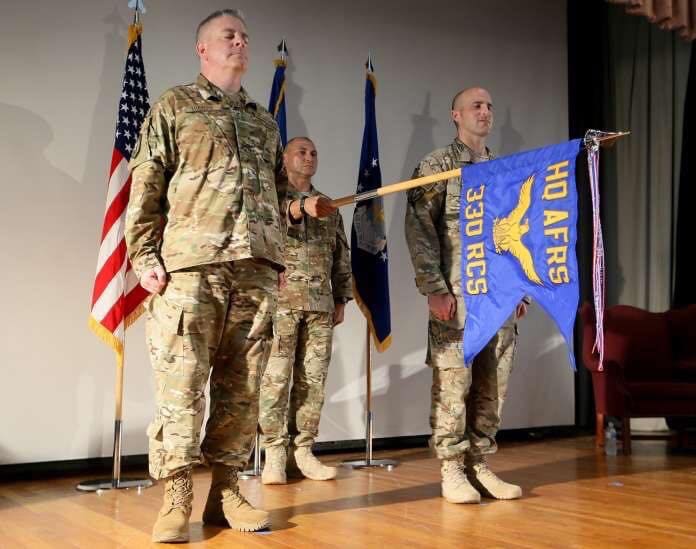
Kerns comes to AFRS with more than a decade of experience as a special tactics officer. The 330th RCS is designed to recruit and access the next generation of Special Operations Airmen and combat support forces, which include combat controllers, pararescuemen, special operations weathermen, tactical air control party, survival evasion resistance and escape (SERE), and explosive ordnance disposal (EOD).
According to Kerns, this recruiting squadron is necessary because you cannot mass produce special operators.
“The old model of taking someone off the street to recruit for the Battlefield Airmen pipeline showed a 90 percent attrition rate,” he said. “Out of 100 people, only 10 would make it. This was not only a challenge for the recruiting force to have such low numbers on a high level of candidates, but also a large monetary cost for the Air Force itself.”
Previously, a trainee would be assessed and trained by traditional recruiters, attend Basic Military Training, then begin the indoctrination course. Now, recruiters of the 330th RCS train and access potential candidates alongside contract developers, who are retired service members with experience in special operations and combat support roles.
Master Sgt. Richard Geren, a 330th RCS flight chief for the Texas area, spoke on the importance of selecting the right candidates for Battlefield Airmen and combat support missions.
“First, we make sure they are qualified for the Air Force,” Geren said. “Once we know they are qualified, we see if they are a good fit to become a Battlefield Airman.”
According to Geren, a good fit includes the right mindset, attitude and understanding of the demands of the Battlefield Airmen career fields.
“I want to sit down with every person to explain the ins and outs of every single job we are recruiting for,” he said. “I also want to share stories and examples of what a pararescueman or combat controller’s worst day might be. It’s not all Hollywood and cool gear. It’s about hard work, determination and teamwork.”
Similarly, recruiters took a unique approach to understanding the career fields they seek candidates for by immersing themselves in to Battlefield Airmen training. Kerns commended the squadron for attending the week-long indoctrination before activing the squadron and then closed the ceremony by speaking directly to the 330th RCS members.
“We will become an audacious display of innovation and collaboration,” he said. “We will succeed in bringing the highest quality of warriors the Air Force and the world has ever seen. You embody these qualities; they are forged through a pursuit of personal excellence and enduring great challenge so that you can inspire young men and women to follow you to their combat calling.”
Air Education and Training Command
Air Force Special Operations Command


If it is “Battle Field Airmen” they should have thrown USAF Security Forces in as well. If it is USAF Special Operations, they should have pulled EOD out.
USAF SF are expeditionary Battlefield Airmen. There’s zero assessment or selection for cops. In fact, many end up there because they fail out of a different Tech school.
While EOD and SERE do not have Operational SOF missions, they support SOF and have day-to-day duties which require increased physical demands over other AFSCs. Consequently, candidates are required to pass the PAST as well as selection before beginning their training pipelines. Consequently, they are recruited by a Special Operations Recruiter.
I was speaking with the most senior EOD man in the nation a few days ago and commented that the USAF needs to recruit in different ways, because guys looking for EOD are typically looking at the Army. Guys who want to be professional trigger pulls again, tend to look at the Army.
His reply had nothing to do with what I had said, and instead he voiced opinion on the issues EODmen will face due to the lack of what is taught in the schoolhouse now.
From there the conversation went into Army EOD becoming its own group and some other areas.
SSD- Agreed, I’ve heard USAF recruiters tell kids if they fail out of a school they will become either a cook or cop, but that they will probably have a choice of which one.
Oh look another Air Force article that says “Battlefield Airman…. and EOD”. Telling recruits that we EOD are essentially battlefield airman only for them to get in and realize the AF has no intention of actually making a BA position. Not really complaining we get plenty of the extra pays and benefits, it’s just getting a bit silly. I had been in the career field only a couple of years when the issue of giving a beret along with BA was brought up, I felt I hadn’t been in long enough to have an opinion. 10 years later though I think they should do it as a recognition of the men and women of EOD we have lost and their sacrifices.
Once again, they are recruited that way because the EOD careerfield desires to use the PAST and a selection to identify candidates. Drop the PAST requirement and selection and EOD can be recruited just like the rest of the AFSCs in the AF.
Tell your bosses to stop running selection and administering the PAST. But we really know that both of those are continued in a Hail Mary in hopes they will one day get the nod from the Air Staff. Lots of moves are afoot but EOD has not been mentioned.
Speaking as an instructor at the USAF EOD Selection (Preliminary) Course, I can assure you that EOD being “recruited just like rest of the AFSCs in the AF” is NOT a good thing. The USAF selection course has been in existence since the early 60s, long before the BA trend so the bosses will not “stop running selection”. Also, the PAST test has not been a requirement for USAF EOD students for well over a year now and we’ve seen the quality of candidate go down…which translates to higher attrition at NAVSCOLEOD. We’ve had recruiting problems for years due to ignorant, lazy, or blatantly dishonest recruiters trying to fill quotas. I hope this new BA recruiting will help but I’m not holding my breath.
SSD – I see a myriad of prep programs being launched to help those interested to train for the PAST, and then for the actual school houses.
Any recommendations on how to find and assess quality programs and coaches that have an eye for both improving performance and longevity for the trainee? An example that’s top of mind is how do I build the form & capacity to ruck long & heavy without throwing out my back and blowing out my knees?
Are you in DEP already? If so, the motivators are all retired CCT/PJ and are doing a great job of getting the candidates ready.
My understanding is that I’m ineligible for DEP as I move from IRR to the ANG.
Yep, Guard is a totally different beast.